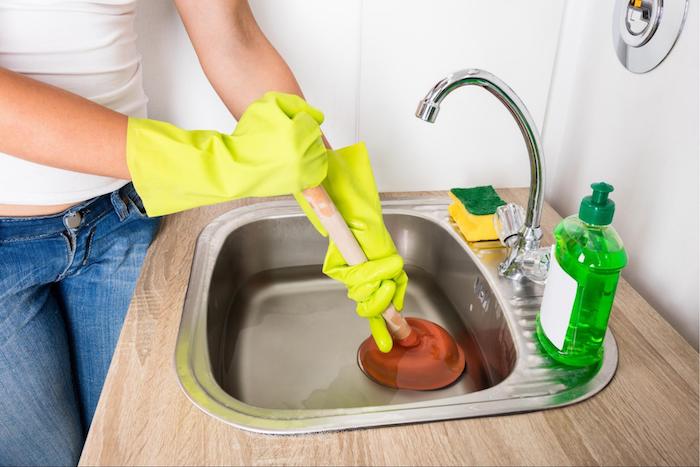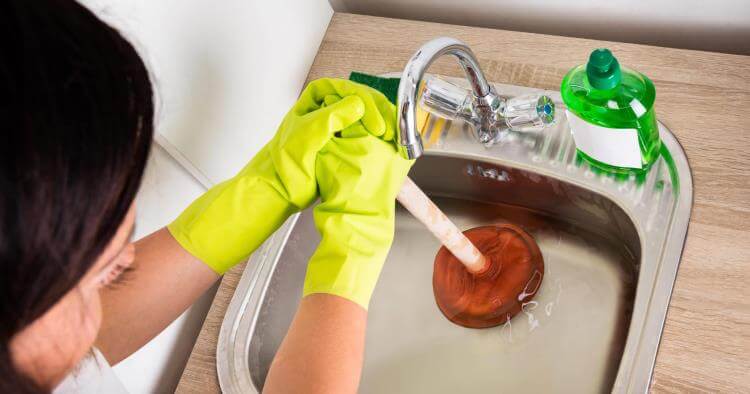Are you dealing with a slow-draining kitchen sink? If so, you are probably frustrated and in need of a quick fix. Fortunately, there are a few easy solutions that can help get things flowing again. This article will cover the steps on how to fix a slow-draining kitchen sink, from checking the sink for blockages to using a chemical drain cleaner. By following these steps, you should be able to restore your kitchen sink to its proper draining state.
Identifying the Problem
It is essential to identify the cause of the slow-draining kitchen sink before attempting to fix it. A clogged sink is usually the most common issue when it comes to slow draining. To determine if a clog is the cause, inspect the pipes beneath the sink for any blockages. If the pipe is blocked, the clog can be removed using a plunger or a plumbing snake. If the pipe is clear, the problem may be caused by a buildup of grease or soap scum in the kitchen sink. To clean the sink, pour a mixture of vinegar and baking soda down the drain, followed by boiling water. This should help break up any grease or soap scum buildup and may help to unclog the sink. If the clog persists, it may be necessary to call a plumber to assess the situation.
Assessing the Drain
When it comes to drainage problems, assessing the issue is the first step in fixing a slow-draining kitchen sink. First, make sure the sink is clean and clear of any debris that may be blocking the drain. Check the garbage disposal, as it may need to be turned off or reset. Next, inspect the trap and the P-trap assembly for any blockages or clogs. Finally, check the pipes leading to the sink for any blockages or clogs. If the problem is not solved by these steps, call a professional plumber to assess the issue.
In some cases, the slow-draining kitchen sink may be due to a buildup of grease and debris. If this is the case, use a chemical-based drain cleaner or a natural solution like baking soda and vinegar to help clear the blockage. For more stubborn clogs, use a plunger or an auger to dislodge the obstruction.
By assessing the drainage problem, understanding the cause, and taking steps to solve it, you can fix a slow-draining kitchen sink. Keep in mind that if the problem persists or is beyond your skill set, call a professional plumber for assistance.
Removing the Clog
Having a slow-draining kitchen sink is a common problem. There are a few simple steps you can take to help unclog your kitchen sink. First, it’s important to determine what is causing the clog. It could be anything from hair or food particles to a buildup of grease and soap residue. Once you’ve identified the cause, you can take the appropriate steps to remove the clog.
One of the easiest ways to remove a clog is to use an enzyme-based drain cleaner. You can find enzyme-based drain cleaners at most hardware stores. These cleaners break down organic materials, such as hair, food particles, and grease, so they can be more easily flushed out of the drainpipe. Alternatively, you can also use a plunger to try and dislodge the clog. Make sure to cover the overflow drain with a wet cloth before plunging to ensure that the pressure is directed toward the clog. If neither of these methods works, you may need to use a plumbing auger to break up the clog.
If your kitchen sink is still slowly draining after taking these steps, it’s time to call a professional plumber. A plumbing professional will be able to assess the situation and advise the best course of action. They will also be able to determine if the clog is located further in the plumbing system and advise on the best way to remove it.
It’s important to take action to remove a clog in your kitchen sink as soon as possible, as the clog can cause problems such as water backing up into the sink and causing a foul odor. Taking the time to identify the cause of the clog and addressing it with the right steps can help you avoid costly repairs in the future.
Cleaning the P-Trap
Have you ever noticed the kitchen sink is draining slower than usual or has a persistent clog? This can be an annoying issue, but it can also be an easy fix. Cleaning the P-Trap can be a simple solution to a slow-draining kitchen sink.
The P-Trap is the curved section of the piping underneath the sink, often shaped like a “P”. It is designed to catch any food, grease, or soap buildup that may be clogging the drain. To clean the P-Trap, start by using a bucket to collect any water. Then, unscrew the pipe and empty the contents into the bucket. Use a cleaning solution, such as a mixture of baking soda and vinegar, to scrub away any residue. Once it’s clean, reassemble the piping and run the tap for a few minutes to ensure the sink is draining properly.
Cleaning the P-Trap of a slow-draining kitchen sink can be a simple and effective solution. Not only does it save time and money from calling a plumber, but it also prevents any mess or damage from trying to fix it yourself. Taking this step can help keep your kitchen sink running smoothly.

Unclogging the Drain
Slow-draining kitchen sinks can be a major nuisance. Fortunately, there are a few simple steps that can help to quickly and easily fix the issue. Unclogging the drain is one of the most common ways to remedy a slow-draining kitchen sink.
Using a plunger is the first step to try. Fill the sink with enough water to fill the plunger cup and then plunge vigorously up and down for several minutes. If this does not work, try using an auger. Insert the auger into the drain and turn the crank handle clockwise. This will help to break up any blockages that may be in the drain.
If the auger does not work, you may need to remove the drain trap. This is a curved pipe located underneath the sink and it can be removed using an adjustable wrench. Before removing the trap, place a bucket underneath it to catch any water. Once the trap has been removed, inspect the pipe for any blockages and remove them.
If the blockage is too far down the pipe to reach, try using a chemical drain cleaner. Follow the instructions on the bottle carefully, as the chemicals can be hazardous if not used properly. Some chemical drain cleaners are safe for septic tanks, so make sure to check the label before use.
By following these simple steps, you can quickly and easily fix a slow-draining kitchen sink.
Replacing the Drain Pipes
When it comes to fixing a slow-draining kitchen sink, the first step is to replace the drain pipes. Replacing the drain pipes can help eliminate clogs, leaks, and other potential issues that could be causing the slow draining. To start, turn off the water supply and remove the old pipes. Then measure the new pipes and cut them to the appropriate length. Once they are cut, use a pipe wrench to attach the pipes to the sink. Make sure that the connections are tight and secure before turning on the water supply. Once the new pipes are in place, fill the sink with water and check for any leaks or blockages. If everything is ok, you should have a functioning kitchen sink with no more slow-draining problems.
Preventative Maintenance
Having a slow-draining kitchen sink can be a real nuisance and can quickly become a major plumbing problem. Fortunately, there are some simple steps you can take to prevent a slow-draining kitchen sink from occurring in the first place. One of the most important things you can do is to regularly clean out the pipes and traps that run beneath your kitchen sink. Doing this will help to ensure that any food, grease, and other debris that may be clogging up the pipes will be removed, thus helping to improve the flow of water.
Additionally, it is a good idea to inspect the pipes and traps every few months for any signs of corrosion or damage. If you do notice any issues, make sure to address them as soon as possible to prevent further damage. It is also a good idea to replace the kitchen sink’s drain stopper every few years to ensure that it is functioning properly. Taking these preventative steps can help to ensure that your kitchen sink will continue to drain freely for many years to come.
Troubleshooting Tips
If you’ve noticed that your kitchen sink is draining slowly, chances are that you have a clog in the pipes. Before you start any troubleshooting, it’s important to understand why a clog might be forming. The most common causes of clogs are food particles, grease, and soap scum that build up over time.
Fortunately, there are a few simple techniques that you can use to troubleshoot and fix a slow-draining kitchen sink. First, try using a plunger to dislodge any blockages. If that doesn’t work, you can use a drain snake to remove blockages further down the pipes. You can also try using a mixture of baking soda and vinegar to dissolve any clogs.
If the clog persists, it may be time to call a professional plumber. They can use specialized tools to locate and remove stubborn blockages. Additionally, a plumber can inspect your pipes and advise you on any potential plumbing issues.
By understanding the causes of a slow-draining kitchen sink and following the above steps, you can successfully troubleshoot and fix the issue. Take the time to regularly inspect your kitchen sink to make sure that it is draining properly and that no clogs are forming.
Conclusion
The best way to fix a slow-draining kitchen sink is to use a plunger to try and dislodge any clogs that are blocking the pipes. If this doesn’t work, you may need to use a plumber’s snake or a chemical drain cleaner to remove the clog. Finally, if all else fails, you may need to replace the entire sink. With a little bit of patience and the right tools, you can easily and quickly fix a slow-draining kitchen sink.


